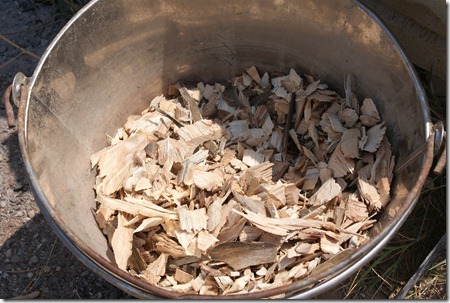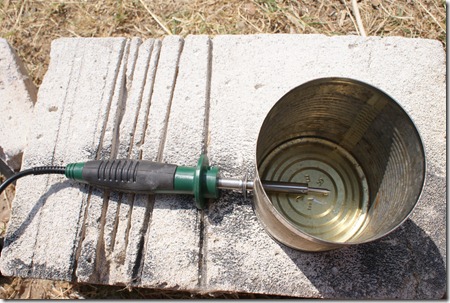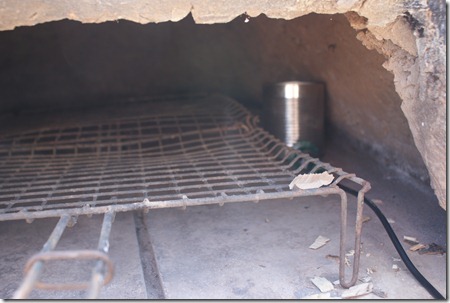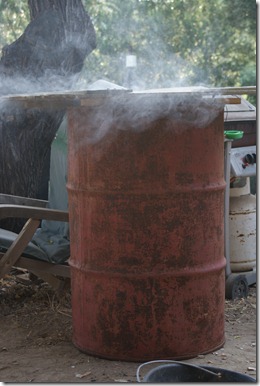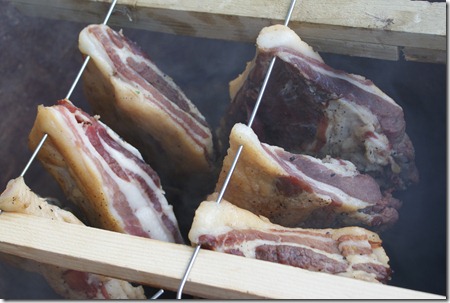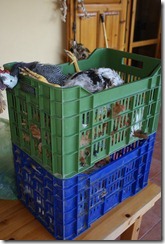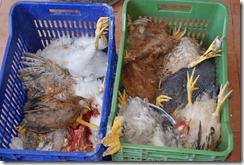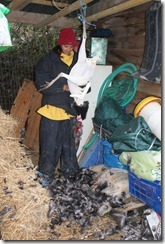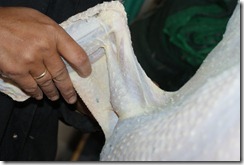Quite a lot has been happening over the last few weeks, most notably it has rained, day after day after day. We are not complaining, as we need the water, but a bit of sun might be nice once in a while. The good news is that we also had some snow, so we rushed up the hill to Smerna to make snowmen etc.
I know itÔÇÖs not much, but for the Peloponnese this really is quite impressive ![]()
So, to get back to the important stuff, this is the time of year that lots of animals are born, and lots of animals get deconstructed and put in the freezer.
Our very first lamb ever arrived on the 5th of February, and is male so is entirely destined for the freezer. Despite this, he seems pleased enough to be here. Our other pregnant ewe is still proving coy, or possibly in denial. Not sure which.
So, that was the life part of the deal -death has been a little more in evidence; we no longer have goats (HURRAH!!!!), but we do have 30kg of assorted chops in the freezer (also HURRAH!!!).
Oddly, the idea of “doing” the goats was much more daunting than the impending pig dispatching (next month?), perhaps because a goat is too small to shoot, so you just hack its throat open with a sharp knife and hope that you get all the important bits in one go. Therefore we resorted to plan B, i.e. asking a neighbour to do it for us. It helps if your neighbour is also Godfather to your child, and has been killing and skinning goats since he was a small child, and sold you the goats in the first place. so this is how we said goodbye to Allie and Amy, our best beloved one-year-old goats:
Rachel (our current WWOOFer) was very impressed by the size of the animals – bigger than the ones she’s used to seeing in Africa, apparently.
Lots of people turned up to get involved – it’s one of those events that attracts an audience.
Note Yiorgos’ full compliance with Health and Hygiene regulations
The finished articles, 15kg apiece, hanging on the veranda overnight, much to the delight of the local cat population. We decided the next day that it was too warm to keep them hanging, so we butchered and vac-packed the bits, to go into the fridge for another few days maturing, before being frozen. Butchery 101 was provided by an excellent article here from The Guardian, of all people.
Note the brand-new hack-saw, which we thought would be a good substitute for a butcher”s saw -it wasn’t. At all. Apparently a tenon-saw works well, but mine is so old and grubby, I didn’t want it anywhere near my lunch, so we made do with just a sharp knife and a meat-cleaver.
Given that it was a first attempt, and the animals are quite big, we spent the best part of three hours on this, but it really was quite easy, following the guide on the internet one cut at a time. (We did nip indoors with the odd bit of carcase to try and work out which but goes where, exactly – but only once or twice).
Finished cuts are in the foreground – mainly ribs so far.
Working into the small hours (6.00 pm, actually) – WWOOFer Rachel doing a great job of boning a shoulder.
And that’s just about the end – what you can see on the table is two entire goats, minus heads and feet. Hardly seems worth the effort.
___________________________________________________
Update – Friday, four days after killing the goats, we had shoulder of lamb a la Jaimie Oliver, and have to report that it was outrageously good. Not trying to be smug – we had many reservations that the meat would have a rank, goaty taste, or just wouldn’t be nice enough to want to eat regularly. Glad to report that one year old goat (no idea what to call it – it would be a wether if it was a sheep) tastes divine. Might not be the same if you have a billy-goat on the premises though.
We also made deviled kidneys, which was a success, and goats-liver pate, which was just about edible. Sweetbreads were enjoyed also. The rest of the grizzly bits are now dog food (although we have kept the intestines for sausage making, assuming we get time).
‘, ‘Life and Death Decisions’, 0, ”, ‘publish’, ‘open’, ‘open’, ”, ‘life-and-death-decisions’, ”, ‘\n(comma\nseparated)’, ‘2012-02-19 14:48:47’, ‘2012-02-19 14:48:47’, ”, 0, ‘http://www.theolivefarm.biz/blog/?p=18’, 0, ‘post’, ”, 0),
![20120209-031_thumb[1] 20120209-031_thumb[1]](http://www.theolivefarm.biz/blog/photos/307e64fbb279_E9F0/20120209-031_thumb1_thumb.jpg)
![20120209-037_thumb[1] 20120209-037_thumb[1]](http://www.theolivefarm.biz/blog/photos/307e64fbb279_E9F0/20120209-037_thumb1_thumb.jpg)
![20120209-047_thumb[1] 20120209-047_thumb[1]](http://www.theolivefarm.biz/blog/photos/307e64fbb279_E9F0/20120209-047_thumb1_thumb.jpg)
![20120209-057_thumb[1] 20120209-057_thumb[1]](http://www.theolivefarm.biz/blog/photos/307e64fbb279_E9F0/20120209-057_thumb1_thumb.jpg)
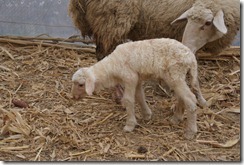
![20120213-001_thumb[1] 20120213-001_thumb[1]](http://www.theolivefarm.biz/blog/photos/307e64fbb279_E9F0/20120213-001_thumb1_thumb.jpg)
![20120213-003_thumb[1] 20120213-003_thumb[1]](http://www.theolivefarm.biz/blog/photos/307e64fbb279_E9F0/20120213-003_thumb1_thumb.jpg)
![20120213-005_thumb[2] 20120213-005_thumb[2]](http://www.theolivefarm.biz/blog/photos/307e64fbb279_E9F0/20120213-005_thumb2_thumb.jpg)
![20120213-008_thumb[3] 20120213-008_thumb[3]](http://www.theolivefarm.biz/blog/photos/307e64fbb279_E9F0/20120213-008_thumb3_thumb.jpg)
![20120213-009_thumb[2] 20120213-009_thumb[2]](http://www.theolivefarm.biz/blog/photos/307e64fbb279_E9F0/20120213-009_thumb2_thumb.jpg)
![20120213-014_thumb[2] 20120213-014_thumb[2]](http://www.theolivefarm.biz/blog/photos/307e64fbb279_E9F0/20120213-014_thumb2_thumb.jpg)
![20120214-001_thumb[1] 20120214-001_thumb[1]](http://www.theolivefarm.biz/blog/photos/307e64fbb279_E9F0/20120214-001_thumb1_thumb.jpg)
![20120214-002_thumb[1] 20120214-002_thumb[1]](http://www.theolivefarm.biz/blog/photos/307e64fbb279_E9F0/20120214-002_thumb1_thumb.jpg)
![20120214-005_thumb[1] 20120214-005_thumb[1]](http://www.theolivefarm.biz/blog/photos/307e64fbb279_E9F0/20120214-005_thumb1_thumb.jpg)
![20120214-007_thumb[1] 20120214-007_thumb[1]](http://www.theolivefarm.biz/blog/photos/307e64fbb279_E9F0/20120214-007_thumb1_thumb.jpg)
![20120214-012_thumb[1] 20120214-012_thumb[1]](http://www.theolivefarm.biz/blog/photos/307e64fbb279_E9F0/20120214-012_thumb1_thumb.jpg)
![20120214-016_thumb[2] 20120214-016_thumb[2]](http://www.theolivefarm.biz/blog/photos/307e64fbb279_E9F0/20120214-016_thumb2_thumb.jpg)
![20120214-020_thumb[1] 20120214-020_thumb[1]](http://www.theolivefarm.biz/blog/photos/307e64fbb279_E9F0/20120214-020_thumb1_thumb.jpg)
